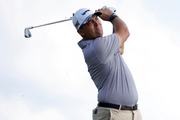
USA Today via Reuters
Aug 17, 2024; Greenbrier, West Virginia, USA; Jon Rahm on the 5th hole at The Old White at the Greenbrier. Mandatory Credit: Bob Donnan-USA TODAY Sports

USA Today via Reuters
Aug 17, 2024; Greenbrier, West Virginia, USA; Jon Rahm on the 5th hole at The Old White at the Greenbrier. Mandatory Credit: Bob Donnan-USA TODAY Sports
“Let your body dictate how you can swing. Simple as that,” Jon Rahm once said. And you probably already know why he said that. How does someone go from a physical deformity to becoming a world-class athlete? Sounds unbelievable, right? But Rahm is a living proof that it’s possible.
Watch What’s Trending Now!
Rahm was born with a clubbed right foot. When he was born, his right foot was twisted at a 90-degree angle. Doctors had to break the bones in his leg and put him in a cast from below the knee. Just imagining that is enough to make your heart sink.
But even as a kid, Rahm was just as bold and relentless as he is today. “I think every week I had to go back to the hospital to get recasted… my leg didn’t grow at the same rate,” he once recalled. His right leg is still about a centimeter and a half shorter than the other. This leaves very limited ankle mobility for the former world number 1.
ADVERTISEMENT
This is exactly what makes his rise so staggering! In a sport like golf —where balance, torque, and flexibility are the core —Rahm has very cleverly used his disability as an ability, using it for his advantage.
Out now. @JonRahmOfficial explains how putting “Mind over Matter” has driven his rise in pro golf. As part of an exclusive documentary series about the #RolexFamily, he talks about channelling his emotions and improving his focus. More on https://t.co/8yaaxUMjn2 #Reachforthecrown pic.twitter.com/DkowyaDWpF
— ROLEX (@ROLEX) August 5, 2025
In a video posted by Rolex on YouTube, the Spaniard shares his secret. Due to his clubfoot, Rahm also suffered from very little mobility in his wrists. So, although he can’t bend his wrist backwards, he can rotate it unusually far forward. His wrist is hypermobile —something most players don’t have. This unique flexibility helps him maintain a strong, bowed wrist at the top of his swing, which stores and releases energy more efficiently than a traditional swing
ADVERTISEMENT
He became the first European ever to win both the US Open and the Masters in his career — claiming the 2021 US Open and 2023 Masters titles, defeating Brooks Koepka and Phil Mickelson. He became the world number 1 in 2020, just four years after turning pro. And although he is known for his frequent outbursts on the course when performing underwhelmingly, Rahm has shown considerable patience in dealing with his deficit.
“I learned at a very young age that I’m going to be more efficient at creating power and be consistent from a short swing.” Because of his physical limitations, Rahm’s hips don’t rotate as far back as most players, and his shorter leg affects his balance. So, a shorter backswing allows him to stay grounded and generate power through torque and wrist lag, not just range of motion. That’s why his swing looks compact, but still explosive.
ADVERTISEMENT
And he has kept this consistency throughout, finishing in the top 10 in almost all of LIV Golf events this year, including LIV Golf Andalucia (2) and LIV Golf Mexico City(4). On the Major front, too, he secured T8 at the PGA Championship and T7 at the US Open.
So, from Jon Rahm, we learn. But he isn’t the only player to overcome physical challenges. The golf circuit is filled with such examples.
Top Stories
Top 3 PGA Tour Pros Who Missed Their Card After RSM Classic

Tour Pro Hit With Brutal 5-Month Punishment Only 11 Days After Celebrating Career Feat

Jordan Spieth Set to Pay a Heavy Price for Unexplained PGA Tour Absence

Jack Nicklaus’ Former Company Announces Bankruptcy After $50M Lawsuit Defeat

Nelly Korda Makes Personal Request to LeBron James After He Showed Support for LPGA Pro

ADVERTISEMENT
Golfers who turned limitations into power plays
Calvin Peete didn’t pick up a golf club until his early 20s, after a childhood fall from a tree fractured his left elbow. The injury healed without surgery, leaving his arm permanently bent. Because he couldn’t straighten it, his swing looked different—but it actually helped him control his shots. He became the most accurate driver on the PGA Tour and even won the PGA Tour driving accuracy title and was called “Mr Accuracy” for 10 straight years (1981–1990) and won 12 events, including the 1985 Players Championship, known as golf’s unofficial “fifth major”
Charlie Owens had blurred vision from an eye condition called iritis. When his medicine got too expensive, he used herbal tea and sunglasses to manage it. Even with this challenge, he won two Senior PGA Tour events in 1986. He’s remembered as a pioneer and is in both the Florida Sports Hall of Fame and the African American Golfers Hall of Fame.
These examples are not limited to the PGA circle. Even LPGA players like Kristy McPherson, who was diagnosed with Still’s disease at age 11 and was told she could never play competitive sports, finished second in the 2009 Kraft Nabisco Championship and ended up building a successful LPGA career. And Stacey Lewis, who, after spending seven years in a back brace for scoliosis, became world number 1, won multiple majors, including the 2013 Women’s British Open, and led Team USA at the Solheim Cup.
ADVERTISEMENT
Lewis told ESPNHS Magazine, “I think the biggest thing is just to never give up. When somebody tells me it can’t be done, I say, ‘Watch me.” This mindset not only helped her succeed individually, but also lead a new generation of American golfers—as both a major champion and national team captain.
These are stories of reinvention — of athletes who worked in full collaboration with their bodies, not despite them. That’s brave and radical.
ADVERTISEMENT
ADVERTISEMENT
ADVERTISEMENT

